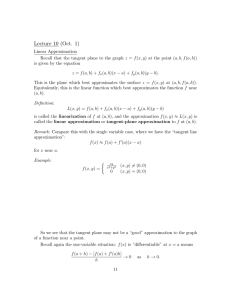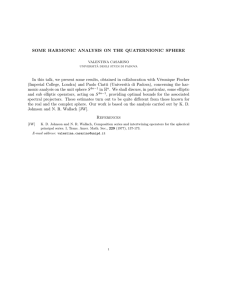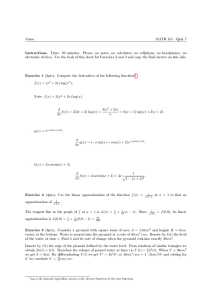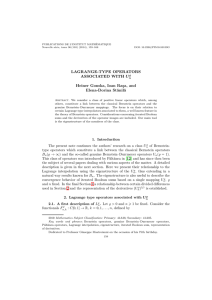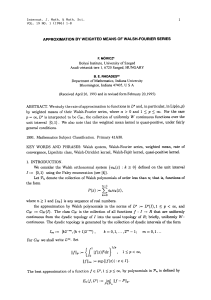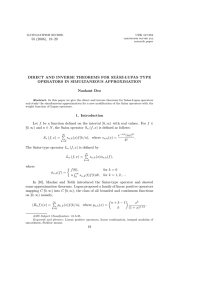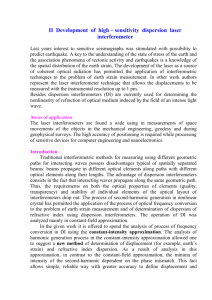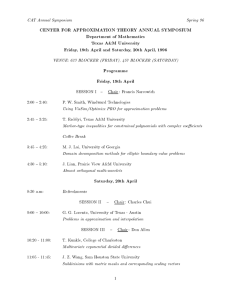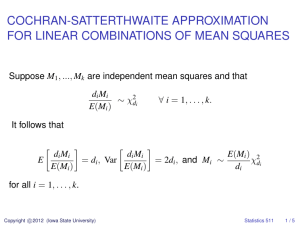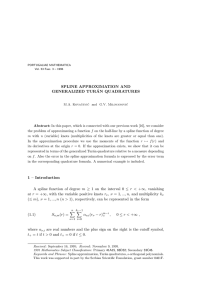CERTAIN CONTRIBUTIONS OF THE ROMANIAN SCHOOL OF NUMERICAL ANALYSIS AND APPROXIMATION THEORY
advertisement
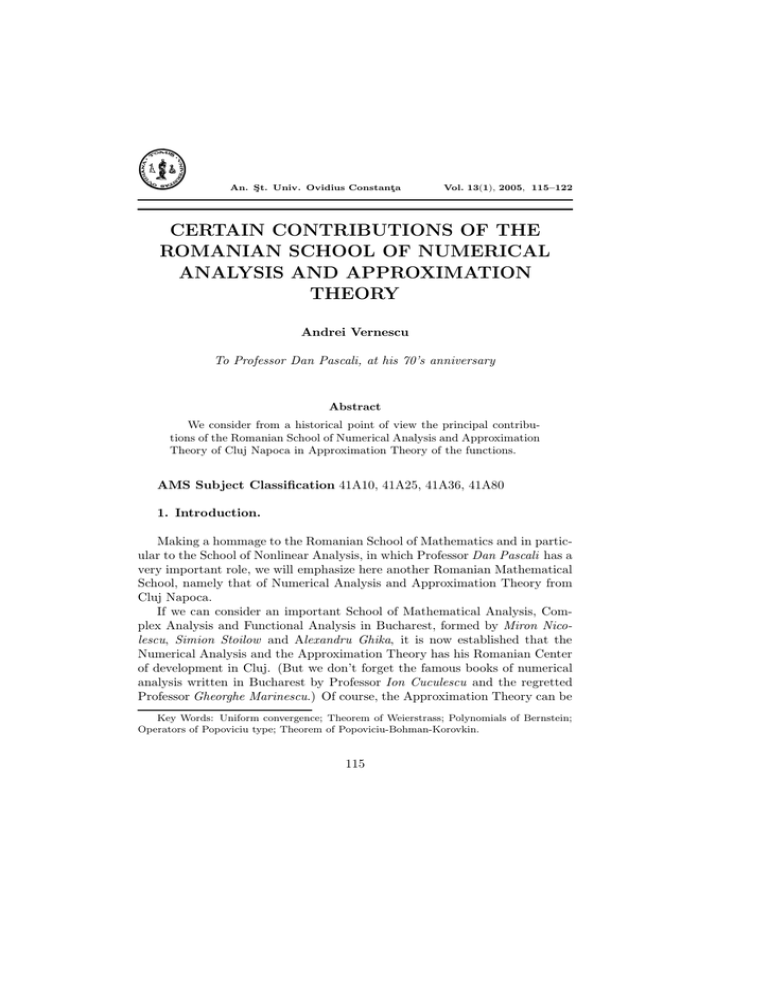
An. Şt. Univ. Ovidius Constanţa Vol. 13(1), 2005, 115–122 CERTAIN CONTRIBUTIONS OF THE ROMANIAN SCHOOL OF NUMERICAL ANALYSIS AND APPROXIMATION THEORY Andrei Vernescu To Professor Dan Pascali, at his 70’s anniversary Abstract We consider from a historical point of view the principal contributions of the Romanian School of Numerical Analysis and Approximation Theory of Cluj Napoca in Approximation Theory of the functions. AMS Subject Classification 41A10, 41A25, 41A36, 41A80 1. Introduction. Making a hommage to the Romanian School of Mathematics and in particular to the School of Nonlinear Analysis, in which Professor Dan Pascali has a very important role, we will emphasize here another Romanian Mathematical School, namely that of Numerical Analysis and Approximation Theory from Cluj Napoca. If we can consider an important School of Mathematical Analysis, Complex Analysis and Functional Analysis in Bucharest, formed by Miron Nicolescu, Simion Stoilow and Alexandru Ghika, it is now established that the Numerical Analysis and the Approximation Theory has his Romanian Center of development in Cluj. (But we don’t forget the famous books of numerical analysis written in Bucharest by Professor Ion Cuculescu and the regretted Professor Gheorghe Marinescu.) Of course, the Approximation Theory can be Key Words: Uniform convergence; Theorem of Weierstrass; Polynomials of Bernstein; Operators of Popoviciu type; Theorem of Popoviciu-Bohman-Korovkin. 115 116 Andrei Vernescu considered a special part of the Functional Analysis, but it has a particular character being indicated only to a single big problem and working more in certain (important)particular spaces. The School of Cluj was formed in the years 1930 by the work of two romanian mathematicians and professors of the University of Cluj: Tiberiu Popoviciu (1906-1975), a former member of Romanian Academy, and Dumitru V. Ionescu (1901-1985). They have formed initially a strong mathematical Center, with the mentioned preoccupations and this was after few years the Romanian School of Numerical Analysis and Approximation Theory of Cluj Napoca. Now this School is leaded by Professor Dimitrie D. Stancu (born in 1927), Ph. D, Dr. H.C., Honorary Member of Romanian Academy. Many domains are studied in this School. We can mention the following list of topics: I. Interpolation theory; II. Numerical differentiation; III. Orthogonal polynomials; IV. Numerical quadratures and cubatures; V. Taylor-type expansions; VI. Approximations by linear positive operators; VII. Representations of remainders in linear approximation formulas in two variables; VIII. Probabilistic methods in theory of uniform approximation of continuous functions; IX. Use of interpolation and calculus of finite differences in probability theory. In this report we will emphasize only some aspects connected to the point VI, namely the construction of the linear positive operators of approximation; in this domain, the Romanian School has obtained remarkable results. But, unfortunately, two results in which Tiberiu Popoviciu was deeply implicated were not sufficiently emphasized by him as his original discoveries, and so a great Romanian priority was not in a correct measure emphasized. We can consider that the Romanian priority in these domains was in a certain sense lost. The two mentioned results are: (a) The operators of Tiberiu Popoviciu type; (b) The theorem (criterion) of Popoviciu-Bohman-Korovkin. The problem of the construction of the approximation operators was posed, as it is well known, starting from the famous approximation theorem of K. Weierstrass (1885) which affirms that every continuous function defined on a compact interval [a, b] on the real axis is a uniform limit of a sequence of polynomials. 117 On certain Contributions In 1912, in a famous work [4] ”Démonstration du théorème de Weierstrass, fondée sur le calcul des probabilités”, S. Bernstein gave one of the first constructive proofs of the theorem of Weierstrass. He has introduced, for f ∈ C[0, 1], the sequence of polynomials (Bn f )n defined by the equalities: (Bn f )(x) = n kn xk (1 − x)f (kn) (n = 0, 1, 2, . . .). k=0 These are called today the polynomials of Bernstein. We have so a sequence of operators Bn : Bn : C[0, 1] → C[0, 1] and: Bn f −−−−−→ f (n→∞) (unif ormly). 2. The operators of Tiberiu Popoviciu type The discovery of S. Bernstein was very important. His operator has conducted, as it is very known, to the idea of finding other linear positive operators Ln : C[0, 1] → C[0, 1], so that Ln f −−−−−→ f (uniformly) and so that of (n→∞) generalizing the operator of Bernstein. Initially, the results in this domain were few, but the problem became more important after the years 1930. One of the first possibilities to obtain such operators was given by Tiberiu Popoviciu in his paper published in 1932, ”Remarques sur polynômes binomiaux” [30]. A sequence of polynomials (pn )n with deg(pn ) = n for each n = 0, 1, 2, . . . is called to be of binomial type, if we have the identities: pn (x + y) = n kn pk (x)pn−k (y) (n = 0, 1, 2, . . .) k=0 identically satisfied. In his paper [32], Tiberiu Popoviciu has required more, namely: (i) pn (1) = 0 for any n = 0, 1, 2, . . . (ii) pn (x) ≥ 0 on [0, 1], for any n = 0, 1, 2, . . . He has defined the operator Tn : C[0, 1] → C[0, 1] by the equalities: n n (Tn f )(x) = 1pn (1) pk (x)pn−k (1 − x)f (kn) . k k=0 118 Andrei Vernescu In the same paper, Tiberiu Popoviciu gave the convergence property of his operators. Of course, in the particular case pn (x) = 1, for any n ∈ N, he finds again the operator of Bernstein. But, unfortunately, Popoviciu has not more emphasized these ideas also in other publications (possibly in foreign journals) and so his work and his priority in the construction of the operators of binomial type were not very well known in the international mathematic community. 3. The Theorem of Popoviciu-Bohman-Korovkin In a modern form, the theorem is the following: Let (Ln )n be a sequence of linear operators Ln : C[0, 1] → C[0, 1]. If Ln e0 −−−−−→ e0 , Ln e1 −−−−−→ e1 , Ln e2 −−−−−→ e2 uniformly (where (n→∞) (n→∞) (n→∞) ek (x) = xk , x ∈ [0, 1], k ∈ N), then Ln f −−−−−→ f (also uniformly), for (n→∞) every f ∈ C[0, 1]. Tiberiu Popoviciu has obtained a conclusion very close to it in this paper [32] of 1950. After Tiberiu Popoviciu, the problem has been revisited once again by the Danish mathematician H. Bohman in [5]. But the theorem appears very clear emphasized only in 1959 in the book of P.P.Korovkin[13]. So, a new Romanian priority was lost! The theorem is usually called ”‘Bohman-Korovkin theorem”, but in the light of the above comments could be called ”‘Popoviciu-Bohman-Korovkin” theorem. 4. The modern works in approximation operators of the Romanian School leaded by D.D.Stancu In 1968, in a fundamental paper [38], D.D.Stancu has defined in a probabilistic way the operators Sn<α> : C[0, 1] → C[0, 1], Sn<α> = 1p<α> (1) n n n <α> (x)p<α> p n−k (1 − x)f (kn) , k k k=0 where the polynomials p<α> of D.D.Stancu are defined by the following equalk ities p<α> (x) = x(x + α)(x + 2α) · . . . · (x + (k − 1)α) and p<α> (x) = 1. 0 k The sequence (Sn<α> )n converges uniformly to f ∈ C[0, 1], for each f . It is one of the most important results of the Romanian School of Numerical Analysis and Approximation Theory. In the case α = 0 we find again the operator of Bernstein. Other important papers of D.D.Stancu in this direction were [39] and [40]. 119 On certain Contributions Another class of approximation operators was obtained by Grigor Moldovan. In 1984, in [23], Constantin Manole has examined again the operators of Tiberiu Popoviciu type using the finite operatorial calculus of Gian-Carlo Rota and his colaborators (Ronald Mullin, Steven Roman, Andrei Odlyzko, David Kahaner and others), also called Umbral Calculus. Luciana Lupaş and Alexandru Lupaş in [20] have also defined by Umbral Calculus an approximation operator, namely: n Q n pk (nx)pn−k (n − nx)f (kn) , Ln f (x) = 1pn (1) k k=0 where Q is a delta-operator (i.e. shift invariant: E a Q = QE a for any E a , where (E a p)(x) = p(x + a), and Qe1 = c = 0) and (pn )n is its basic sequence (p0 = 1, pn (0) = 0, n ≥ 1 and Qpn = npn−1 ). A small generalization is given in my work [50], published in ”Analele Ştiinţifice ale Universităţii Ovidius – Constanţa”. In the work [45], D.D.Stancu and myself have given a bidimensional approximation of Tiberiu Popviciu type, also using theUmbral Calculus. Recently, a young researcher of Cluj, Maria Crăciun, has constructed in her thesis, elaborated under the guidance of D.D.Stancu, some approximation operators using the sequences of polynomials of Sheffer type. An extensive series of important results was obtained by the continuators of the works of Tiberiu Popoviciu, Dumitru V. Ionescu and Dimitrie D. Stancu: Gh. Coman, A. Lupaş, W. Breckner, Şt. Cobzaş, Gh. Micula. Other important contributions in the domain of positive linear operators of approximation were obtained by C. Manole, P. Blaga, I. Gavrea, F. Stancu, I. Raşa, M. Ivan, G. Moldovan, O. Agratini, O. Dogaru, I. Gânscă, Şt. Măruşter, L. Lupaş, V. Miheşan, D. Acu, I. Chiorean, C. Cismaşiu, A. Ciupa, D. Kácso, R. Trâmbiţaş, R. Păltănea, D. Bărbosu, A. Vernescu, F. Sofonea, M. Crăciun and others. References [1] Agratini O., Aproximare prin operatori liniari, Presa Universitară Clujeană, ClujNapoca, 2000. [2] Agratini O., Binomial Polynomials and their Applications in Approximation Theory, Conf. Sem. Mat. Univ. Bari 2001 (28), 1-22. [3] Altomare F., Campiti M.: Korovkin-Type approximation and its applications, De Gruyter, Berlin New York, 1994. [4] Bernstein S.N., Démonstration du théorème de Weierstrass, fondée sur la calcul des probabilités, Commun. Soc. Math., Kharkow, (13) 2 (1912), 1-2. 120 Andrei Vernescu [5] Bohman H.: On approximation of continuous and of analytic functions, Ask. Mat. (2), 3 (1951), 43-51. [6] Cheney E. W., Introduction to Approximation Theory, Chelsea Publishing Company, New York, 1982. [7] Coman Gh., Analiză numerică, Editura Libris, Cluj Napoca, 1995. [8] Davis Ph. J., Interpolation and Approximation, Dover Publications, Inc., New York, 1975. [9] De Vore R., The approximation of continuous functions by positive linear operators, Lecture notes in Mathematics 293, Springer Verlag, Berlin, 1972. [10] De Vore R., Lorenz G.G., Constructive Approximation, Springer Verlag, Berlin, 1993. [11] Gavrea I., Aproximarea funcţiilor prin operatori liniari, Editura Meridianmira, ClujNapoca, 2001. [12] Hildebrand F.B., Introduction to Numerical Analysis, Mc Graw-Hill, New York, 1956. [13] Korovkin P.P., Linear operators and approximation theory, Delhi, 1960 (sau ediţia n limba rusă, Editura de Stat pentru literatură fizico-matematică, Moscova, 1959). [14] Lorenz G.G., Approximation of functions, Chelsea Publishing Company, New York, 1986. [15] Lupaş A., Contribuţii la teoria aproximării prin operatori liniari, teză de doctorat, Cluj-Napoca, 1976. [16] Lupaş A., A Dobinski-type formula for binomial polynomials, Studia Math. Univ. Babeş-Bolyai, 33 (1998), 40-44. [17] Lupaş A., The approximation by means of some liniar positive operators, IDoMAT 95 Dortmund, Math. Research vol. 86 (1995), 201-229. [18] Lupaş, A., Classical polynomials and approximation theory, Kolloquium Vortrag Univ. Duisburg, Dec. 1996. [19] Lupaş, A., Approximation operators of binomial type, Proc. of IDoMAT 98, Birkhäuser Verlag, Witten, (1998). [20] Lupaş L., Lupaş A., Polynomials of binomial type and approximation, Studia Univ. Babes-Bolyai, Mathematica, 32 (1987), 61 - 69. [21] Lupaş L., Teoria constructivă a funcţiilor, Editura Universităţii din Sibiu, 1994. [22] Manole C., Dezvoltări n serii de polinoame Appell generalizate, cu aplicaţii la aproximarea funcţiilor, teză de doctorat, Cluj-Napoca, 1984. [23] Manole C., Approximation operators of binomial type. Univ. Cluj-Napoca, Research Seminar on Numerical and Statistical Calculus, Preprint Nr. 9 (1987), 93 -98. [24] Mastroianni G., Occorsio M.R., Sulle derivatta dei polinomi di Stancu, Rendiconti dell’Academia di Scienze Fisiche e Matematiche della Societa Nazionale di Scienze, Lettere e Arti di Napoli, Serie IV-vol 45, 1978. On certain Contributions 121 [25] Miheşan V., Aproximarea funcţiilor continue prin operatori liniari şi pozitivi, teză de doctorat, Cluj-Napoca, 1998. [26] Moldovan Gr., Generalizări ale polinoamelor lui S.N. Bernstein, Rezumatul tezei de doctorat, Cluj-Napoca, 1971. [27] Natanson I.P., Constructive function theory, Frederik Ungar Publishing Co., New York, 1964. [28] Păltănea R., Approximation by linear positive operators: estimate with second order moduli, Editura Universităţii ”Transilvania”, Braşov, 2003. [29] Popoviciu T., Despre cea mai bună aproximaţie a funcţiilor prin polinoame, Cluj, 6 (1931), 146-148. [30] Popoviciu T., Remarques sur les polynômes binomiaux, Bull.Soc.Math. Cluj, 6 (1932) 8 - 10. [31] Popoviciu T, Asupra polinoamelor care formează un şir Appell, Bull. Math. de la Soc. Roum. de Sci., 33-34 (1932), 22-27. [32] Popoviciu T, Asupra demonstraţiei teoremei lui Weierstrass cu ajutorul polinoamelor de interpolare, Lucrările Sesiunii Generale Ştiinţifice Acad. R.P.R. (1950), 1664 - 1667. [33] Roman S., The Umbral Calculus, Academic Press, Inc. New York 1984. [34] Rota G.C., Finite Operator Calculus, Academic Press, New York, 1975. [35] Rota G.C., Kahaner D., Odlyzko A., On the foundations of combinatorial theory, Finite operator calculus, Journal of Mathematical Analysis and Applications, 42 (1973), 685 - 760. [36] Sablonnière P., Positive Bernstein-Sheffer operators, J. Approx. Theory, 83 (1995), 330-341. [37] Stancu D.D., Evaluation of the remainder term in approximation formulas by Bernstein Polinomials, Amer. Math.Monthly, 70 (1963), 260-261. [38] Stancu D.D., Approximation of functions by a new class of linear polynomial operators, Rev.Roum.Math.Pures et Appl., 13 (1968), 1173-1194. [39] Stancu D.D., On a new positive linear polynomial operator, Proc. Japan. Acad., 44 (1968), 221 - 224. [40] Stancu D.D., Use of probabilistic methods in the theory of uniform approximation of continuous functions, Rev. Roum. de math. pures et appl., 14 (1969), 673-691. [41] Stancu D.D., A new class of uniform approximating polynomial operators in two and several variables, Proc.of the Conf.on Constr.Theory of Functions, Budapest (1969). [42] Stancu D.D., Two classes of positive linear operators, Analele Univ. din Timişoara (Seria Şt. Mat.), (1970), 213-220. [43] Stancu D.D., Aproximarea funcţiilor de două şi mai multe variabile printr-o clasă de polinoame de tip Bernstein, Studii şi cercetări matematice, 22 (1970), 335-345. 122 Andrei Vernescu [44] Stancu D.D., Curs şi culegere de probleme de Analiză numerică, Univ. Babeş-Bolyai, Fac. Mat., Cluj-Napoca, 1977. [45] Stancu D.D., Approximation of functions by a new class of linear polynomial operators, Revue Roumaine de Math. Pures et Appl., 13 (1980), 1173-1194. [46] Stancu D.D., Vernescu A.: Approximation of bivariate functions by means of a class of operators of Tiberiu Popoviciu type, Studii şi cercetări matematice (Mathematical Reports), (1999). [47] Stancu D.D., Coman Gh., Agratini O., Trâmbiţaş R.: Analiză Numerică şi Teoria Approximării, vol I, Presa Univ. Clujeană, Cluj Napoca, 2001. [48] Vernescu, A., On the use of the umbral calculus to construct approximation operators of binomial type, Studia Universitatis ”Babeş-Bolyai”, Mathematica, 42 (1997), 111116. [49] Vernescu, A., Approximation Operators Constructed by means of Umbral Calculus, Third Conference of. S.S.M.R., Craiova, 1999. [50] Vernescu, A., Construirea unui operator liniar de aproximare, Analele Ştiinţifice ale Univ. Ovidius, Constanţa, 8, (2000),(1), 175-186. [51] Vernescu, A., Teză de doctorat, Cluj Napoca 2000. Universitatea Valahia, Târgovişte Catedra de Matematică Bd. Unirii, nr. 118,130082 Târgovişte Romania
